P55 Extreme Overclockers: Check your sockets!
by Rajinder Gill on October 15, 2009 12:01 AM EST- Posted in
- Motherboards
We start with a picture.

The picture above is after our Core i7 870 (LGA-1156) processor was overclocked up to 5.19GHz using our cascade with a -102° Celsius evaporator head temperature under full-load. Processor VCC power draw at these frequencies is around 160W (this is possible only due to subzero cooling), as measured with a clamp meter installed at the 12V EPS power lead. Study the pictures closely and you should notice something peculiar. Keep in mind it comes from a CPU installed in the same type of socket from a particular manufacturer.
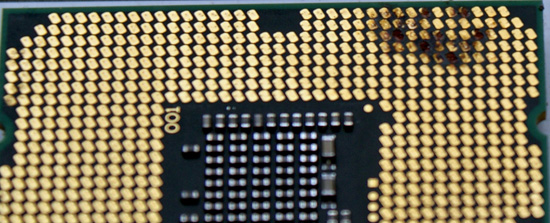
What happens after several extreme benchmark runs...
If you noticed something weird in the pictures then you understand the title of our article. We have what seems to be a potentially serious issue with proper socket loading on several P55-based motherboards when overclocking to the limit. We are of course not the only ones experiencing the problem as several of our overclocking peers have run into the same problem.
Normally we do not worry too much about mishaps during extreme overclocking testing as they are typically caused by factors outside of the supplier’s control. The overriding concern is that we have damaged every motherboard in our possession for the P55 overclocking (extreme) shootout as well as two very expensive i7/870 processors. These problems are the cause of a single component and are repeatable. As such, we thought we would provide details on current problems and will provide an update once all of the motherboard manufacturers affected have had a chance to properly respond.
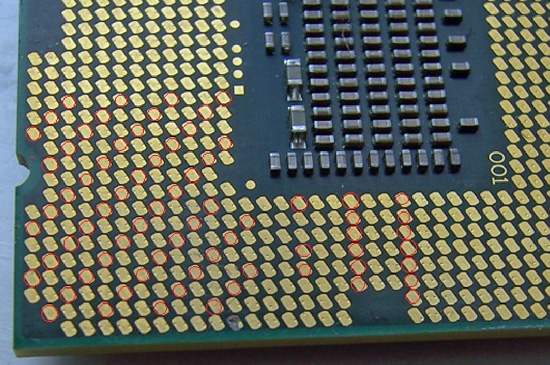
We draw your attention to the fact that the processor shown in this pictures exhibits signs of insufficient pin-to-pad contact (little to no contact) in what is a rather reproducible pattern with Foxconn manufactured 1156 sockets. As soon as an end-user mounts a CPU in a socket and latches the clamp mechanism, each pin should leave a notable mark on the associated pad.
We've marked locations where this does not seem to have happened, showing what appears to be a significant reduction in the number of VCC/VSS pins for proper power delivery, and certainly not at the right load line resistance. Damage resulting from highly overclocked use in these types of situations is not solely limited to the processor; let’s take a look at what happened to some of the motherboards in which these CPU were seated.
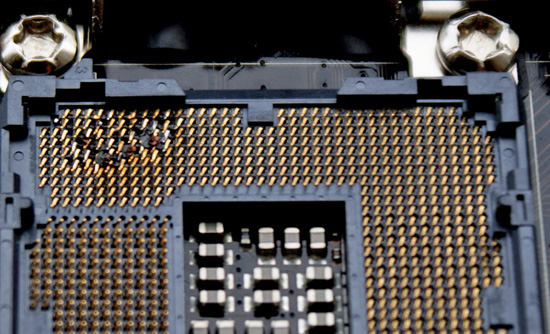

When Intel publishes socket specifications and design tolerances, it's up to component manufacturers to strictly adhere to them when designing, manufacturing, testing and ultimately selling their "compliant" components. Of course, that's not to say Intel could not have goofed when releasing their specification, leaving out a crucial tolerance or such. It could happen, but not likely. For the time being, let's assume that's not the case; seeing as how processors installed in sockets built by other companies have exhibited no such issue in testing to date.
At first glance, one might be inclined to think LGA-1156 based processors are intolerant of high-end overclocking, almost as if by design. This is correct to some extent; a quick glance at Intel’s white papers for socket 1156 CPU’s reveals that there are around 175 pads for VCC compared to over 250 for socket 1366 CPU’s. This means socket 1156 has around 66% of the current capacity of socket 1366, the caveat being that when overclocked, processors from both platforms draw similar levels of current.
When overclocked above 4GHz, processors from both platforms will draw around 15-16 amps via the EPS 12V rail to VCC, VTT and some of the other sub –system power rails under full 8 thread load from the Intel burn test (Linx). Assuming 85% PWM efficiency, we’re looking at power draw in the region of 130-140w to VCC on both platforms. The facts point toward tighter current handling tolerances for socket 1156 when compared to socket 1366, especially when it comes to non-connection of VCC/VSS power delivery pins.
Fortunately, we think we've been able to isolate pin to pad contact issues to one particular brand of parts. Physical inspection and end-user reports all but confirm the issues only affects sockets manufactured by Foxconn at this time. The only known alternative sockets in the wild are made by LOTES or Tyco AMP. We happen to have a couple of boards from EVGA using the LOTES/Tyco AMP sockets and MSI/DFI using the LOTES socket design, and thus far those boards have been issue free given highly similar operating conditions. In fact, we’ve managed to push our LGA-1156 processors further in heavy load tests on boards made using LOTES/Tyco AMP sockets than those made with sockets from Foxconn; something we’re not putting down solely to coincidence.
So far, EVGA is the only company we know that uses sockets exclusively from LOTES on their top-tier P55 boards - for example, the EVGA P55 Classified 200, model E659. This by the way may be the onus behind the decision to market the board’s “300% More Gold Content” socket statement as a purchasing option point. If you find yourself shopping for an EVGA P55 FTW, model E657, you've got a 50/50 chance of buying one with a Tyco AMP socket design (using a LOTES backplate), as opposed to one made solely with Foxconn's, the same goes for MSI and DFI who have batches of boards in the retail channel using LOTES sockets (although we're not entirely sure on socket specifics at this point). DFI told us earlier they have dropped usage of the Foxconn sockets completely until further notice. We hear the LOTES and Tyco AMP sockets are in short supply, which is probably why Foxconn's been able to fill the void in the market with what we believe to be a lower quality alternative for the extreme overclocker.
We took one of our damaged CPU’s and inserted it into one of the EVGA (LOTES/Tyco AMP) boards and took a few pics to show contact scoring and a side by side compare to the original Foxconn socket indents.
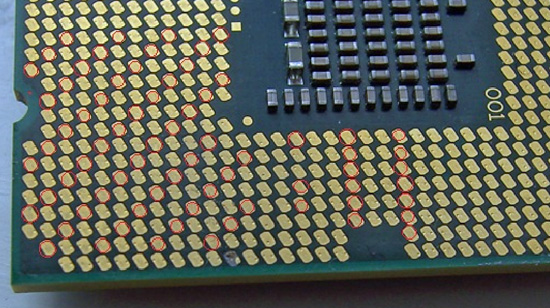
Foxconn 1156 Socket Installation
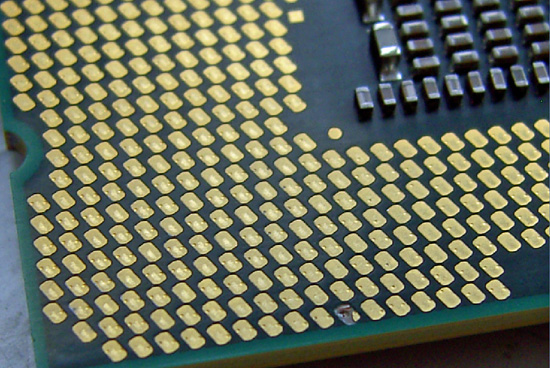
Tyco AMP / LOTES 1156 Socket Installation
Note how from a variety of angles certain pads show no evidence of contact from a Foxconn pin at all. Both the Tyco AMP and LOTES sockets have a larger pin/pad contact surface area leaving a slight scuff mark in the central area of each pad. In light of this, what we will say is that if you’re thinking of doing extreme overclocking on a board built using Foxconn's socket 1156, think again. Or, at least check your CPU for evidence of proper pin-to-pad contact.
We have not had any problems with air or water cooling overclocking up to 4.3GHz, although we do have a i5/750 that has developed a few dark pads after a thousand hours or so of constant overclocking. However, none of the boards have developed pin problems so we feel very safe in saying that any problems will probably occur only in extreme overclocking scenarios.
We also realize that partial responsibility for some of the less than acceptable CPU installations may be in fact due user installation errors. However, if users are screwing this up by doing nothing different than what they've always done when it comes to handling and installing LGA-type processors, then it's hard for us to find fault with the installer. Be aware of this situation and study the pin imprint on the CPU pads and make sure you have good contact on the VCC/VSS power delivery pads before pushing the system too hard.
















273 Comments
View All Comments
ClagMaster - Saturday, October 17, 2009 - link
Intel/Foxconn has warranted these products to the consumer as being fully functional for a reasonable period of time provided they are operated within design parameters (such as frequency, voltage and current). If the processor was operating at the rated power of 95W (i.e. no overclocking with liquid N2) and these pins arced and failed within the warranty period would result in replacement or refund of the product by Intel or the motherboard manufacturers.This is a just and responsable redress for product failure.
This product failure is not a life-threatening situation and would not attact the attentions of attorneys who specialize in these lawsuits. Not enough money to extract in this case since loss of life has special emotional impact for those who have undue regard for human life.
Overclocking a CPU is deliberate abuse. Overclockers keep pushing the limits until something fails. Failure during overclocking is the responsiblity of the owner. The failures shown in this article occured during extreme overclocking and is the overclockers responsability. Intel/Foxconn has no control over over someone deliberately exceeding established design limits and cannot be held responsable. Its foolish to speak of litigation under these circumstances.
How many of you people have turned over a LGA 775 CPU and counted the dimple marks on the bottom of the CPU? I should disassemble my E6600/Intel DG965HW rig right now to make sure! I do not think the process Foxconn and others use for making the socket pins (their length) has changed between LGA775 and LGA1156.
Has anyone considered the tensioning mechanism for LGA1156 has changed. And there may well be less compressive force on the processor resulting in pin-to-land contact less than that of LGA775. Shimming with light cardstock between the CPU and clamp would solve this problem. The difference between Foxconn and other brands could be the height of the post the end of the bracket engages.
I think LGA1156 pin-to-land contact is sufficient for normative usage at 95W.
Being an American myself, I have a low opinion of selfish, cowardly, fear-ridden opportunists who think themselves special and abuse tort laws for selfish purposes. This has been encouraged by the American legal community (lawyers, judges and legistors) who have lost their moral compass (justified in part by seperation of church and state) and profit greatly from this. And the American media and education establishments have played their roles in this debasement by creating unreasonable expections and lazy mental habits. For them the ends justifies the means and over the years these people have really brought American culture to the current low level of dependency, fear, selfishness, and greed.
I am disgusted with where my country has gone and where it is going. The political and social initiatives of the 1960's has not raised the American people to the highest standards. Instead, they have lowered everyone to the lowest common denominator. This is all part of a program of inwardly directed Imperialism by the American government to disabuse its citizens of responsable self-government and make them dependent subjects. You cannot have freedom without personal responsability.
Consumers are responsable for their choices. And I reject the consumerist notion that the consumer is always right.
Kaleid - Sunday, January 3, 2010 - link
OT but I wouldn't go to any church to look for a moral compassMrwright - Monday, October 19, 2009 - link
I would like to point out something: I am the person who posted the pic of my i7 860 on extreme systems forums - and guess what, I had never overclocked that cpu and I was experiencing erratic behavior with it crashing etc, so the problems are not only confined to "extreme" overclocking!Also everyone is arguing what proper contact marks even are? either a pin prick or scuff mark? People are saying that new cpus have marks on them For the factory, Well just a thought.. does intel not use foxconn to manurfacture most of their boards I bet when testing the 1156 cpus it would have been on a foxconn socket!
1stguess - Saturday, October 17, 2009 - link
Well, Absolutely no one can tell me with certainty that this i5 rig of mine with Foxconn socket would not fail within the next two years of normal usage before i upgrade. I've never been much of a gambler.2 hours prior to writing this post I mailed my i5 750 & Asrock p55 Motherboard back to retailer for a refund. I don't need the headaches.
Unfortunately for some, the window for refund or exchange of their computer components has shut. Foxconn, due to manufacturing the only socket reported with consistent p55 burnout, is the odd man out.
I totally understand why people are mad as hell.
What will i do now? I think 1366 920.
ClagMaster - Saturday, October 17, 2009 - link
I would not worry too much about it if you do not overclock because of this appearent issue. There are many other things that could go wrong with a mobo besides the pin ends arcing. This should not happen with normative currents and voltages.Personally I think the problem is there is not enough compressive force on the CPU with the new clamp design to force the CPU against all of the pins. I find it difficult to believe the pin lengths (rather the variablity of pin lengths) is any different between LGA 775 and LGA 1156. However, the clamp design is.
If I had a P55/LGA1156 motherboard, I would cut some card stock (about 5 mils) and shim it between the clamp and CPU. This will apply additional compressive force so all pin ends will contact the CPU lands and provide a little extra insurance. Its a simple fix. All you need is card stock (such as the back cover of the mobo manual), an razorblade, a cutting board from the kitchen, and a little patience. Its not hard to make and fit.
Are you mad or just afraid of the risk? Its too bad you sent in the i5 750 and Asrock p55 back to the retailer for a refund. It had not failed you during the time you owned it.
Solaire - Saturday, October 17, 2009 - link
Whether the problem lies within the pin length or in the clamp design does not matter. A person should not have to create a shim to ensure proper contact between the CPU and socket no matter whether they are overclocking or not.petergab - Saturday, October 17, 2009 - link
I have some questions here:1. When do you expect the answers from the Motherboard manufactures? 2. Is it possible that just some badges were faulty?
3. Any comments from foxconn?
4. Do you know of any (possible) reports without OC attributed to this problem?
5. How much was your i5-750 overclocked? How long did it take to form the dark pads?
6. This will have a damaging efect on every system in the long-run (about 5 years) even without OC, won't it?
Raji?
rickbee - Saturday, October 17, 2009 - link
Is it possible that 1366 boards are also affected, has anyone checked for lack of pin/pad contact?Fleeb - Saturday, October 17, 2009 - link
Read the article and the comments thread. It has been mentioned several times. P55 sockets only.JDD - Saturday, October 17, 2009 - link
First a big thanks for Raja for this info, I know the guys at anandtech are always on top of things.I was searching other sites but not finding a lot of this issue of pins not making contact with all the pads . Could this be that people are just not noticing it unless they have a reason to remove the CPU? I just wanted to know what other people are saying, or if they even know?